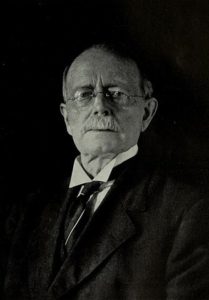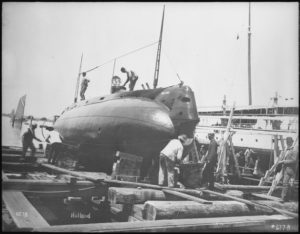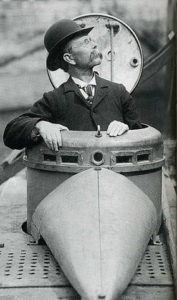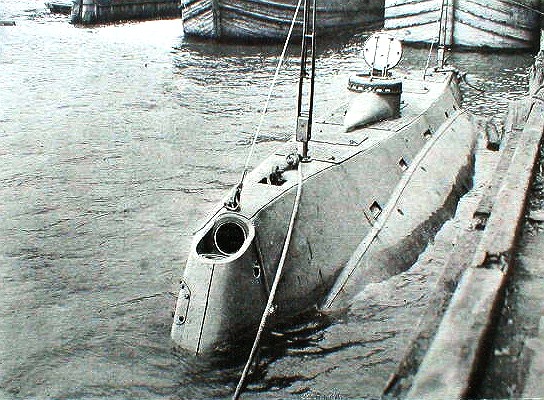-

Portrait of John Philip Holland before 1915. Photo: U.S. National Archives, public domain August 12th 2014 marked the 100th anniversary of the death of John Philip Holland, a Clare man recognized as “the father of the modern submarine.” Much of Holland’s pioneering work on submarines was done after he emigrated to the United States in 1873.
Despite many challenging times and rough currents, Holland persevered for decades to refine and perfect his vision of a submersible craft.
For all his life, the sea was an essential element of Holland’s life. It started with his father, John Holland, who patrolled the headlands of Clare as a “riding officer,” essentially a roving coastal patrolman with the British Coastguard Service.
While reports differ as to whether Holland was born on Feb. 29, 1840 or Feb. 24, 1841, there is no doubt about where he came into the world – on the wild Atlantic coastline of Liscannor, just north of Lahinch.
A well-known ballad about Holland,* often sung by the late Micho Russell (March 15, 1915 – February 19, 1994) of Doolin, Co. Clare, explains:
It was in Liscannor he was born in the wild west coast of Clare,
Not far from the Cliffs of Moher that hangs so high in the air.
Liscannor Bay stretches far away, from Hag’s Head to Rineen,
For young John Philip Holland who invented the submarine.
Holland attended St. Macreehy’s National School and then the Christian Brothers School (C.B.S.) in the nearby town of Ennistymon. During the Great Hunger, he lost one of his younger brothers, Robert, and two uncles to the illnesses that swept the country.
In 1852, his father retired and the family moved to Limerick where Holland studied at the Limerick C.B.S. When the elder Holland died soon after, John Philip ended up teaching in a number of Christian Brothers schools in Ireland to help with the family finances. Ultimately, Holland joined the Christian Brothers and took the name of Brother Philip.
On Nov. 3, 1858, Brother Philip was assigned to the North Monastery school in Cork where he met Brother James Dominic Burke, a Limerick man, noted science teacher and founder of vocational training in Ireland. Burke encouraged Holland in his plans for a submarine and as early as 1859, he completed his first drafts of a sub, a design he never radically changed.
Over the years, the inventive Holland also built a number of useful items at the schools where he taught.
Ill health later forced him to leave the Christian Brothers in 1873. By then, Holland’s mother and two brothers had emigrated to Boston. He booked passage – in steerage – to meet them there, and worked for a time with an engineering firm.
Ultimately, Holland joined St. John’s Parochial School in Paterson, N.J., as a lay teacher again under the auspices of the Christian Brothers.
Funding to continue development of his submarine came through Holland’s brother, Michael, who was involved with the Fenian Movement. The Fenians and the inventor teamed up in an effort to build a submarine to use against the British Navy.
Throughout the next two decades, Holland worked with a number of corporate backers to advance his submarine prototypes, and achieved a level of success that was shadowed at the same time by financial and bureaucratic struggles.
Finally, on St. Patrick’s Day, 1898, Holland’s first successful, full-fledged trial run of diving and surfacing while underway in his Holland VI occurred off Staten Island, N.Y.
A demonstration 10 days later for the U.S. Navy convinced then-Assistant Secretary of the Navy Theodore Roosevelt to recommend the purchase of a Holland submarine. Despite the support of such an influential figure, it would be another two years before the Navy finally contracted to go ahead with the deal.
On April 11, 1900, the date now celebrated as the birthday of the U.S. Submarine Force, the Navy finally bought Holland VI — for $150,000, just half of its design cost, The Navy did quickly order seven more.

On October 12, 1900, the Navy’s first submarine was officially commissioned as USS Holland (later SS-1).
The 53-ft.-long submersible incorporated the submarine design principles Holland had validated in the Fenian Ram 20 years earlier, and became the prototype for virtually all modern submarines.
Other countries, including Great Britain, and the Netherlands, later purchased Holland’s submarine designs. Holland built two subs for Japan that were used against Russia in the war of 1904-5, earning him the Rising Sun from the Emperor of Japan for his contribution to the Japanese naval victory.

Over the years, the U.S. Navy has named two submarine tenders for John Holland: USS Holland (AS-3), commissioned in 1926; and a second USS Holland (AS-32), commissioned in 1963.
Holland died at the age of 73 from pneumonia, in Newark, N.J. He was survived by his wife of 27 years, the former Margaret Foley of Paterson, N.J., along with three sons and one daughter. Two other daughters and one son had predeceased him.
Holland is buried in Holy Sepulchre Cemetery in the Paterson suburb of Totowa, N.J., just a mile from the Passaic River where he first tested Holland I in 1878.
His gravestone, redone in 1976, includes a sculptural version of an iconic photo – characterized by Holland’s walrus mustache and bowler hat as he emerged from the conning tower of Holland VI.
In 1964, a plaque was erected in Liscannor commemorating the fiftieth anniversary of his passing. Castle Street has also been renamed Holland Street in his honor.
*This song was written by Breandán Higgins of Lahinch. The air is that of “Amhrán na Trá Báine.”


Your article on John P. Holland, The Irish Man Who Invented the Submarine, contains an excellent diagram of of Holland’s submarine
This diagram is worthy of inclusion in Wikipedia, whichI could do depending on any Copyright restrictions.
Could you please advise me of the source of this diagram and/or its Copyright provisions.
Or perhaps you could enter the diagram into Wikipedia article on John P. Holland.
Thank you,
Thomas Banfield
the submarine is Spanish invention, the invention Isaac Peral, dirty English are envious and traitors.
Point of info. John Holland also taught at Maughhawn School before going to US. Site makes no actual reference to “Fenian Ram” – original sub built for Fenian Brotherhood. This vessel alone would provide entire article. A.F.
Please, just read about theses spanish people and these dates::
1860: Cosme García Sáez (1818-1874)
1859: Narciso Monturiol (1819-1885)
1888: Isaac Peral (1851-1895)
History is a little different that what I have read about Submarine’s. As far
I was aware, the first submarine, perhaps not that great was built by a
French man in Quebec, Canada, when it was a French Colony.
My understanding up to now was that the first submarine was built by a French Canadian in Quebec,Canada, when Canada belonged to France.
It’s an excellent article giving a clear view of Mr. Holland’s life. However, as I have previously stated, the first submarine was built by a French Canadian in Quebec, then a Frency Colony, according to what I learned.